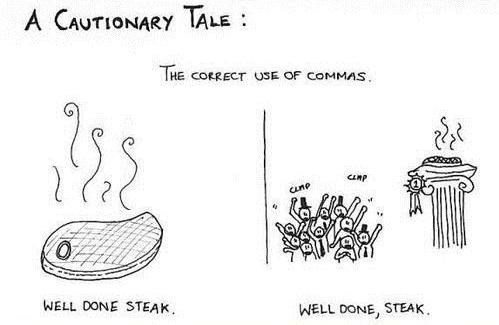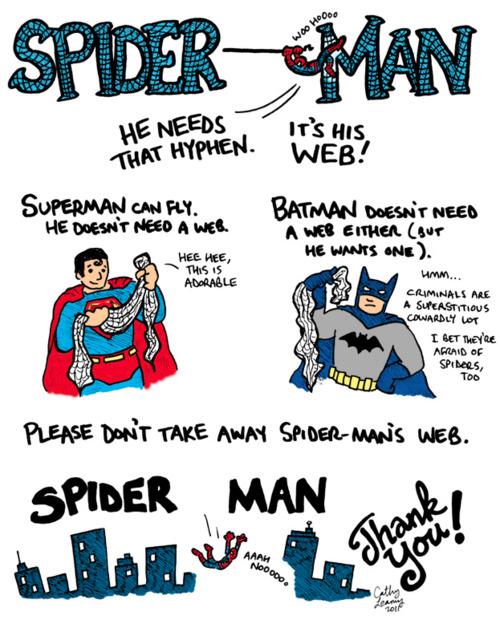1. Use Commas in Lists
Use commas to separate elements in a list of three or more items. Items in a list may bay nouns:
He received a bicycle, a new computer, a board game, and a watch for his birthday.
Jennifer ate a hamburger, potato chips, and some ice cream for lunch.
Jennifer ate a hamburger, potato chips, and some ice cream for lunch.
Items in a list can also be verb forms:
I enjoy hiking, playing golf, and reading in my free time.
Peter bought the ticket, had a quick lunch, and boarded the plane for Denver.
Peter bought the ticket, had a quick lunch, and boarded the plane for Denver.
Note: Difference between British and American English
British English generally does not place a comma before the final
'and' in a list. American English, on the other hand, also places the
comma before the final 'and'.
UK: I bought some soap, towels and a tooth brush.
USA: I bought some soap, towels, and a tooth brush.
USA: I bought some soap, towels, and a tooth brush.
2. Use Commas to Separate Adjectives
Commas are used to separate adjectives that are similar in nature which are placed directly before the noun they modify.
Peter enjoys intricate, complicated journeys.
She spent money on expensive, wasteful, unimaginative clothes.
She spent money on expensive, wasteful, unimaginative clothes.
If the adjectives describe different aspects of the noun, no commas is used.
Peter bought a fast new red corvette last week.
Jane is looking for a used round metallic object.
Jane is looking for a used round metallic object.
Note: Remember that adjective order is important when using more than one adjective to modify a noun.
3. Use Commas with Subordinate Clauses Which Begin Sentences
Subordinate clauses are also known as dependent clauses.
In other words, they must be used with independent clauses because they
can not stand on their own. For example, these two subordinate clauses
are not complete without another, independent clause to complete the
sentence.
If he comes
Although it was difficult
Although it was difficult
Subordinate clauses can be placed at the end of sentences, or at the
beginning of sentences.
When placing subordinate clauses at the
beginning of sentences, use a comma.
Although he was late, we had a good time.
OR
We had a good time although he was late.
OR
We had a good time although he was late.
She usually stays for lunch when she comes to visit.
OR
When she comes to visit, she usually stays for lunch.
OR
When she comes to visit, she usually stays for lunch.
4. Use Commas with Coordinating Conjunctions
Coordinating conjunctions
are often referred to as FANBOYS (for, and, but, or, yet, so).
Coordinating conjunctions connect two simple sentences to make a
compound sentence.
I worked hard on the project yesterday, but I haven't finished it yet.
She stayed out until midnight, and she got up early for work the next day.
She stayed out until midnight, and she got up early for work the next day.
5. Use Commas with Introductory Comments
Words that introduce sentences such as linking words, sequencing
words or other connective adverbs (consequently, however, moreover,
etc.) are followed by a comma in English.
However, we decided to wait on the investment until next quarter.
Finally, let's take a look at what this all means for the future.
Finally, let's take a look at what this all means for the future.
6. Use Commas to Introduce Direct Speech
Direct speech uses quotes ("") to directly repeat what someone else has said. Use a comma before direct speech.
Peter said, "I'm not coming with you this time."
Angie stated flatly, "I hate this job!"
Angie stated flatly, "I hate this job!"
Note: If direct speech begins a sentence, use a comma rather than a period within the quote.
"This is really difficult," said the student.
"It's time we take a vacation," declared Fred.
"It's time we take a vacation," declared Fred.
Note: Do not use a comma in indirect or reported speech. Reported speech is used to report rather than directly state what someone has said.
Mary told me she wanted to join a club.
The teacher said we had to prepare for a test the following week.
The teacher said we had to prepare for a test the following week.
7. Use Commas with Unusual Word Order
Modifying words and expressions are generally placed in a specific
position in a sentence. For example, adverbs of frequency are usually
placed before the main verb. Sometimes, words or expressions are placed
differently to stress a point. In this case, use two commas to offset
this word or expression.
Peter, consequently, decided to stay another week.
The department, hesitant with distrust, refused to consider the idea.
The department, hesitant with distrust, refused to consider the idea.
8. Use Commas with Non-Defining Relative Clauses
Relative clauses can be broken into two types: Defining and non-defining relative clauses.
Defining relative clauses provided essential information, non-defining
relative clauses provide information which is additional, but not
essential, to understanding. Use commas to offset non-defining relative
clauses.
Pete, who was the team captain, came up to bat first.
My house in London, which was built in 1784, is close to all the great attractions.
My house in London, which was built in 1784, is close to all the great attractions.
9. Use Commas with Numbers
Commas are used to separate each group of three numbers for larger numbers.
345,687,341
23,897
23,897
10. Use Commas with Written Dates
Commas separate dates that are written out by placing a comma after the day.
March 10, 1978
August 21, 1997
August 21, 1997
From: http://esl.about.com/od/englishgrammar/a/Comma-Use-For-English-Learners.htm




Nenhum comentário:
Postar um comentário